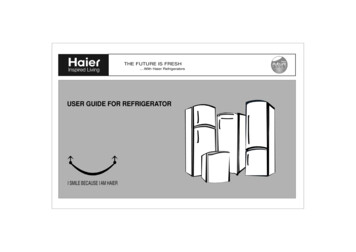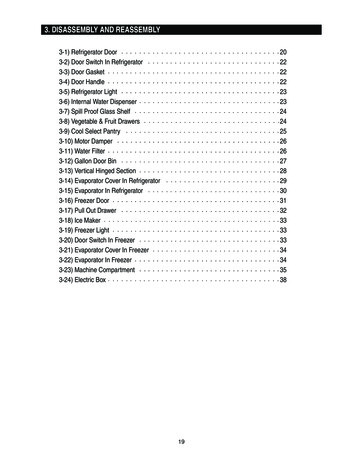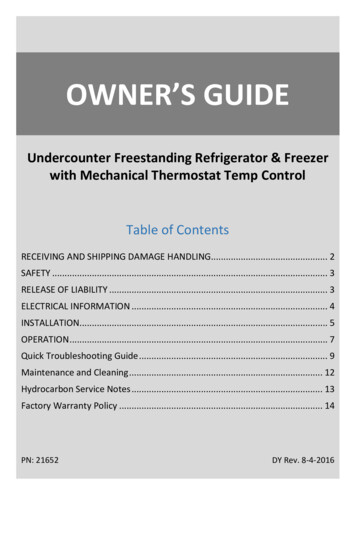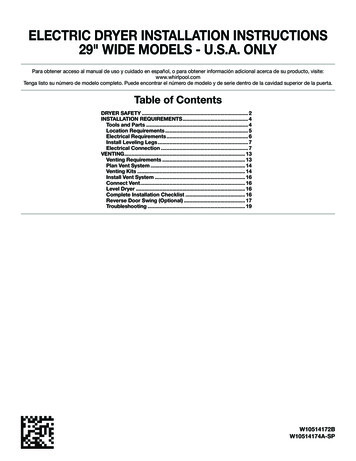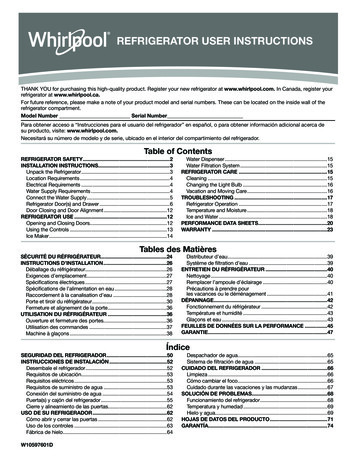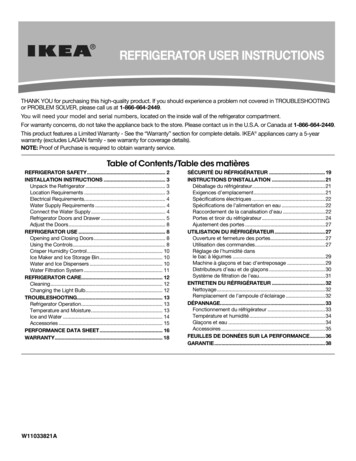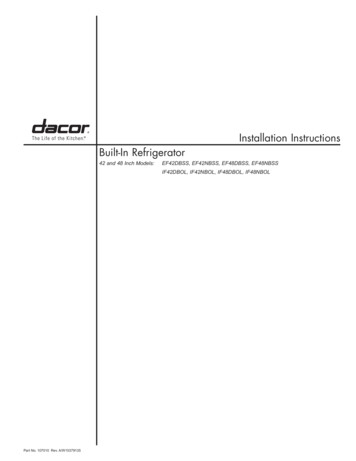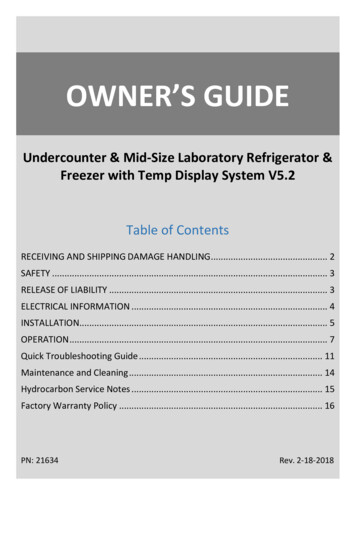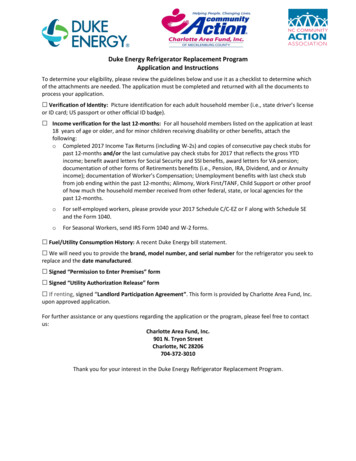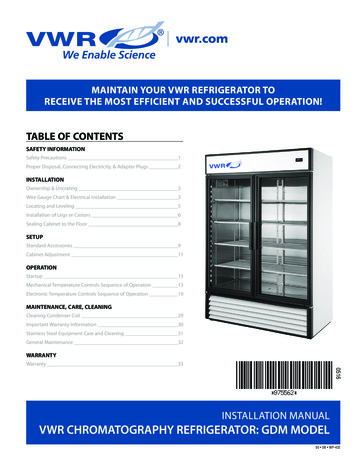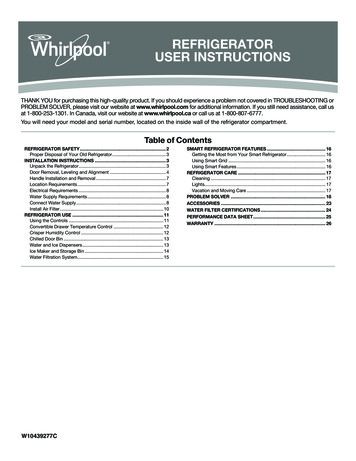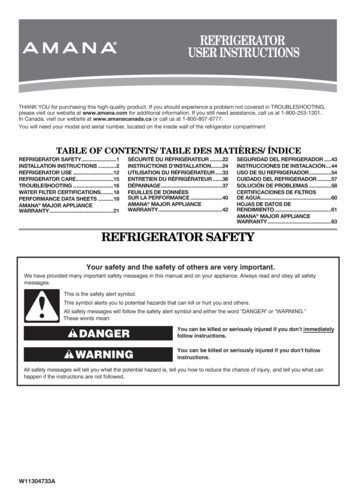
Transcription
REFRIGERATORUSER INSTRUCTIONSTHANK YOU for purchasing this high-quality product. If you should experience a problem not covered in TROUBLESHOOTING,please visit our website at www.amana.com for additional information. If you still need assistance, call us at 1-800-253-1301.In Canada, visit our website at www.amanacanada.ca or call us at 1-800-807-6777.You will need your model and serial number, located on the inside wall of the refrigerator compartmentTABLE OF CONTENTS/ TABLE DES MATIÈRES/ ÍNDICEREFRIGERATOR SAFETY.1INSTALLATION INSTRUCTIONS.2REFRIGERATOR USE.12REFRIGERATOR CARE.15TROUBLESHOOTING.16WATER FILTER CERTIFICATIONS.18PERFORMANCE DATA SHEETS.19AMANA MAJOR APPLIANCEWARRANTY.21SÉCURITÉ DU RÉFRIGÉRATEUR.22INSTRUCTIONS D’INSTALLATION.24UTILISATION DU RÉFRIGÉRATEUR.33ENTRETIEN DU RÉFRIGÉRATEUR.36DÉPANNAGE.37FEUILLES DE DONNÉESSUR LA PERFORMANCE.40AMANA MAJOR APPLIANCEWARRANTY.42SEGURIDAD DEL REFRIGERADOR.43INSTRUCCIONES DE INSTALACIÓN.44USO DE SU REFRIGERADOR.54CUIDADO DEL REFRIGERADOR.57SOLUCIÓN DE PROBLEMAS.58CERTIFICACIONES DE FILTROSDE AGUA.60HOJAS DE DATOS DERENDIMIENTO.61AMANA MAJOR APPLIANCEWARRANTY.63REFRIGERATOR SAFETYYour safety and the safety of others are very important.We have provided many important safety messages in this manual and on your appliance. Always read and obey all safetymessages.This is the safety alert symbol.This symbol alerts you to potential hazards that can kill or hurt you and others.All safety messages will follow the safety alert symbol and either the word “DANGER” or “WARNING.”These words mean:DANGERWARNINGYou can be killed or seriously injured if you don't immediatelyfollow instructions.You can be killed or seriously injured if you don't followinstructions.All safety messages will tell you what the potential hazard is, tell you how to reduce the chance of injury, and tell you what canhappen if the instructions are not followed.W11304733A
IMPORTANT SAFETY INSTRUCTIONSWARNING: To reduce the risk of fire, electric shock, or injury when using your refrigerator, follow these basic precautions:Plug into a grounded (earthed) outlet.Do not remove ground prong. Do not use an adapter. Do not use an extension cord. Disconnect power before servicing. Replace all parts and panels before operating. Remove doors from your old refrigerator. Use nonflammable cleaner. Do not store or use petrol, flammable liquids or gas in thevicinity of this or other electrical appliances. The fumes cancause fires or explosions. Do not store explosive substances such as aerosol canswith a flammable propellant in this refrigerator. Do not use or place electrical devices inside the refrigeratorcompartments if they are not of the type expresslyauthorized by the manufacture. Use two or more people to move and install refrigerator. Disconnect power before installing ice maker (on ice makerkit ready models only). A qualified service technician must install the water line andice maker. See installation instruction supplied withice maker kit IC13B for complete details. Connect to a potable water supply only. Use a sturdy glass when dispensing ice (on some models).This appliance is not intended for use by persons (includingchildren) with reduced physical, sensory or mentalcapabilities, or lack of experience and knowledge, unlessthey have been given supervision or instruction concerninguse of the appliance by a person responsible for their safety. Children should be supervised to ensure that they do notplay with the appliance. To avoid the risk of children becoming trapped andsuffocating, do not allow them to play or hide inside therefrigerator. If the power supply cord is damaged, it must be replaced bythe manufacturer or its service agent or a similarly qualifiedperson. SAVE THESE INSTRUCTIONSProper Disposal of Your OldRefrigeratorBefore You Throw Away Your Old Refrigerator orFreezer: Take off the doors.Leave the shelves in place so that children may not easilyclimb inside.WARNINGSuffocation HazardRemove doors from your old refrigerator.Failure to do so can result in death or brain damage.IMPORTANT: Child entrapment and suffocation are notproblems of the past. Junked or abandoned refrigerators arestill dangerous – even if they will sit for “just a few days.” Ifyou are getting rid of your old refrigerator, please follow theseinstructions to help prevent accidents.INSTALLATION INSTRUCTIONSRemove the PackagingUnpack the RefrigeratorWARNINGExcessive Weight HazardUse two or more people to move and installrefrigerator.Failure to do so can result in back or other injury.Important information to know about disposal ofrefrigerants:Dispose of refrigerator in accordance with Federal and Localregulations. Refrigerants must be evacuated by a licensed,EPA certified refrigerant technician in accordance withestablished procedures. 2Remove tape and glue residue from surfaces before turningon the refrigerator. Rub a small amount of liquid dish soapover the adhesive with your fingers. Wipe with warm waterand dry.
Do not use sharp instruments, rubbing alcohol, flammablefluids, or abrasive cleaners to remove tape or glue. Theseproducts can damage the surface of your refrigerator. Formore information, see “Refrigerator Safety.” Dispose of/recycle all packaging materials.Location RequirementsWARNINGWhen Moving Your Refrigerator:Your refrigerator is heavy. When moving the refrigerator forcleaning or service, be sure to cover the floor withcardboard or hardboard to avoid floor damage. Always pullthe refrigerator straight out when moving it. Do not wiggle or“walk” the refrigerator when trying to move it, as floordamage could occur.Explosion HazardKeep flammable materials and vapors, such asgasoline, away from refrigerator.Failure to do so can result in death, explosion, or fire.Clean Before UsingAfter you remove all of the packaging materials, clean the insideof your refrigerator before using it. See the cleaning instructionsin “Refrigerator Care.”Important information to know about glass shelvesand covers:Do not clean glass shelves or covers with warm water whenthey are cold. Shelves and covers may break if exposed tosudden temperature changes or impact, such as bumping.Tempered glass is designed to shatter into many small,pebble-size pieces. This is normal. Glass shelves and coversare heavy. Use both hands when removing them to avoiddropping.IMPORTANT: This appliance is intended to be used inhousehold and similar applications such as: Staff kitchen areas in shops, offices and other workingenvironments. Farm houses and by clients in hotels, motels and otherresidential type environments. Bed and breakfast type environments.Catering and similar non-retail applications.To ensure proper ventilation for your refrigerator, allow for 1 2"(1.25 cm) of space on each side and at the top. Allow for 1"(2.54 cm) of space behind the refrigerator. If your refrigeratorhas an ice maker, allow extra space at the back for the waterline connections. When installing your refrigerator next to afixed wall, leave 2¹ 2" (6.3 cm) minimum on the hinge side (somemodels require more) to allow for the door to swing open.NOTE: This refrigerator is intended for use in a location wherethe temperature ranges from a minimum of 55 F (13 C) to amaximum of 110 F (43 C). The preferred room temperaturerange for optimum performance, which reduces electricityusage and provides superior cooling, is between 60 F (15 C)and 90 F (32 C). It is recommended that you do not install therefrigerator near a heat source, such as an oven or radiator. 3
Water Supply RequirementsGather the required tools and parts before starting installation.Read and follow the instructions provided with any tools listedhere.TOOLS NEEDED: Flat-blade screwdriver 1/4" Nut driver 7/16"and 1 2" Open-end ortwo adjustable wrenches 1/4" Drill bit Cordless drill¹ ₂" (1.25 cm)IMPORTANT: Connect to a potable water supply only.Do not use with water that is microbiologically unsafe orof unknown quality without adequate disinfection beforeor after the system. Systems certified for cyst reductionmay be used on disinfected waters that may containfilterable cysts.2¹ ₂" (6.3 cm)Electrical RequirementsWARNING All installations must meet local plumbing coderequirements. Do not use a piercing-type or 3/16" (4.76 mm) saddle valvewhich reduces water flow and clogs more easily. Use copper tubing and check for leaks. Install coppertubing only in areas where the household temperatures willremain above freezing. For models with water filters, the disposable water filtershould be replaced at least every 6 months.Water PressureElectrical Shock HazardPlug into a grounded 3 prong outlet.Do not remove ground prong.Do not use an adapter.Do not use an extension cord.Failure to follow these instructions can result in death,fire, or electrical shock.Before you move your refrigerator into its final location, itis important to make sure you have the proper electricalconnection.Recommended Grounding MethodA 115 volt, 60 Hz., AC only 15 or 20 A fused, groundedelectrical supply is required. It is recommended that a separatecircuit serving only your refrigerator be provided. Use an outletthat cannot be turned off by a switch. Do not use an extensioncord.If the supply cord is damaged it must be replaced by themanufacturer or its service agent or a similarly qualified person.Do not use a cord that shows cracks or abrasion damage alongits length, or at either the plug or connector end.NOTE: Before performing any type of installation, cleaning, orremoving a light bulb, turn the refrigerator to OFF. Dependingon your model, turn the freezer control to the word OFF, orpress the Freezer down arrow touch pad until a dash (–)appears in both the Freezer and Refrigerator displays as shown.Disconnect the refrigerator from the electrical source. When youare finished, reconnect the refrigerator to the electrical sourceand reset the temperature controls to the desired setting. See“Using the Controls.”4A cold water supply with water pressure of between 35 and 120psi (241 and 827 kPa) is required to operate the water dispenserand ice maker. If you have questions about your water pressure,call a licensed, qualified plumber.Reverse Osmosis Water SupplyIMPORTANT: The pressure of the water supply coming out ofa reverse osmosis system going to the water inlet valve of therefrigerator needs to be between 35 and 120 psi (241 and827 kPa).If a reverse osmosis water filtration system is connected to yourcold water supply, the water pressure to the reverse osmosissystem needs to be a minimum of 40 to 60 psi (276 to 414 kPa).If the water pressure to the reverse osmosis system is less than40 to 60 psi (276 to 414 kPa): Check to see whether the sediment filter in the reverseosmosis system is blocked. Replace the filter if necessary. Allow the storage tank on the reverse osmosis system torefill after heavy usage.If your refrigerator has a water filter, it may further reducethe water pressure when used in conjunction with a reverseosmosis system. Remove the water filter. See “WaterFiltration System.”If you have questions about your water pressure, call alicensed, qualified plumber.
Connect the Water SupplyRead all directions before you begin.IMPORTANT: If you turn on the refrigerator before the water lineis connected, turn off the ice maker to avoid excessive noise ordamage to the water valve.Connect to Water Line1. Unplug refrigerator or disconnect power.2. Turn OFF main water supply. Turn ON nearest faucet longenough to clear line of water.3. Find a 1/2" to 1¹ 4" (12.7 mm to 31.8 mm) vertical cold waterpipe near the refrigerator.IMPORTANT: Connect to RefrigeratorDepending on your model, the water line may come downfrom the top or up from the bottom. Follow the connectioninstructions for your model.Style 11. Remove plastic cap from water valve inlet port. Attach thecopper tube to the valve inlet using a compression nutand sleeve as shown. Tighten the compression nut. Do notovertighten. Confirm copper tubing is secure by pulling oncopper tubing.2. Create a service loop with the copper tubing. Avoid kinkswhen coiling the copper tubing. Secure copper tubing torefrigerator cabinet with a “P” clamp.Make sure it is a cold water pipe.Horizontal pipe will work, but the following proceduremust be followed: Drill on the top side of the pipe, notthe bottom. This will help keep water away from the drill.This also keeps normal sediment from collecting in thevalve.4. Determine the length of copper tubing you need. Measurefrom the connection on the lower right rear of therefrigerator to the water pipe. Add 7 ft (2.1 m) to allowfor cleaning. Use 1/4" (6.35 mm) O.D. (outside diameter)copper tubing. Be sure both ends of copper tubing are cutsquare.5. Using a cordless drill, drill a 1 4" hole in the cold water pipeyou have selected. ABCDABCDEFGA.Cold water pipeB.Pipe clampC.Copper tubingD.Compression nutE.Compression sleeveF.Shutoff valveG.Packing nut6. Fasten the shutoff valve to the cold water pipe with the pipeclamp. Be sure the outlet end is solidly in the 1/4" drilledhole in the water pipe and that the washer is under the pipeclamp. Tighten the packing nut. Tighten the pipe clampscrews slowly and evenly so the washer makes a watertightseal. Do not overtighten.7. Slip the compression sleeve and compression nut onthe copper tubing as shown. Insert the end of the tubinginto the outlet end squarely as far as it will go. Screwcompression nut onto outlet end with adjustable wrench.Do not overtighten or you may crush the copper tubing.8. Place the free end of the tubing in a container or sink, andturn ON the main water supply. Flush the tubing until wateris clear. Turn OFF the shutoff valve on the water pipe.A. “P” clampB. Plastic water lineC.Compression nutD.Copper tubing3. Turn on water supply to refrigerator and check for leaks.Correct any leaks.Style 21. Create a service loop (minimum diameter of 2 ft [61 cm])with the copper tubing. Avoid kinks when coiling the coppertubing.2. Remove the plastic cap from water valve inlet port. Place acompression nut and sleeve on the copper tubing.3. Insert the end of the copper tubing into the water valve inletport. Shape tubing slightly so that the tubing feeds straightinto the port to avoid kinks.4. Slide the compression nut over the sleeve and screw intothe water valve inlet port.ABCDA. Plastic water tubingB. SleeveC.Compression nutD.Copper tubing5
5. Using an adjustable wrench, hold the nut on the plasticwater line to keep it from moving. Then, with a secondwrench turn the compression nut on the copper tubingcounterclockwise to completely tighten. Do not overtighten.ABComplete the InstallationWARNINGCDA. “P” clampC.Compression nutB. Plastic water lineD.Copper tubingElectrical Shock HazardPlug into a grounded 3 prong outlet.Do not remove ground prong.6. Check connection by pulling on copper tubing. Attachthe plastic water line to the refrigerator cabinet with a “P”clamp.7. Turn on water supply to the refrigerator and check for leaks.Correct any leaks.Do not use an adapter.Do not use an extension cord.Failure to follow these instructions can result in death,fire, or electrical shock.1. Plug into a grounded 3 prong outlet.NOTE: Allow 24 hours to produce the first batch of ice.Discard the first three batches of ice produced. Allow 3 days tocompletely fill the ice storage bin.6
Refrigerator Door(s) and DrawerTOOLS NEEDED: 5 16", 3 8", 1 4" hex head socket wrench, aTorx† T20 screwdriver, a #2 Phillips screwdriver, and a flat-bladescrewdriver.IMPORTANT: Standard DoorYour refrigerator may have a standard reversible refrigeratordoor with either a freezer door or freezer drawer, or Frenchdoors. Follow the instructions specific to the door style ofyour model. All graphics referenced in the following instructions areincluded later in this section after “Final Steps.” Thegraphics shown for the standard door are for a right-handswing refrigerator (hinges factory installed on the right). If you only want to remove and replace the doors, see“Remove Door(s) and Hinges” and “Replace Door(s) andHinges.” Before you begin, turn the refrigerator control OFF, andremove food and adjustable door or utility bins from thedoors.Remove and Replace Refrigerator Door HandlesStandard Door To remove the handle, remove the screw attaching thetrim to the upper end of the handle. Using a flat-bladescrewdriver wrapped in masking tape, pry the trim piecefrom the lower end of the handle. Then, remove the screwsattaching the handle to the door. See Graphic 2. To replace handle, reverse directions.French DoorsStyle 1 Handles Remove Door and HingesUsing a 3 32" or 1 8" hex key, loosen the two setscrewslocated on the side of each handle. Pull the handle straightout from the door. Make sure you keep the screws forreattaching the handles. See Style 1 Handle, graphic 1.To replace the handles, reverse the directions.Style 2 Handles To remove the handle, grasp the lower part of the handlefirmly, slide the handle up and pull the handle straight outfrom the door. See Style 2 Handle, graphic 1. To replace the handle, position the handle so that the largeholes in the mounting clips are down and align the holeswith the door studs. Rotate the handle so that the mountingclips are flat against the door and slide the handle down toengage. See Style 2 Handle, graphic 1.5 16" Hex-Head Top Hinge ScrewFreezer drawer models1. Unplug refrigerator or disconnect power.2. Keep the refrigerator door closed until you are ready to lift itfree from the cabinet.NOTE: Provide additional support for the door while thehinges are being moved. Do not depend on the door gasketmagnets to hold the door in place while you are working.3. Remove the parts for the top hinge as shown in Top Hingegraphic. Lift the refrigerator door free from the cabinet.4. Remove the parts for the bottom hinge as shown in BottomHinge graphic.Freezer door models1. Unplug refrigerator or disconnect power.2. Keep the freezer door closed until you are ready to lift it freefrom the cabinet.NOTE: Provide additional support for the door while thehinges are being moved. Do not depend on the door gasketmagnets to hold the door in place while you are working.3. Remove the parts for the top hinge as shown in Top Hingegraphic. Lift the refrigerator door free from the cabinet.4. Remove the center hinge pin and remove the hinge screwsas shown in the Center Hinge graphic. Lift the freezer doorfree from the cabinet.5. Remove the base grille by grasping the grille firmly withboth hands and pulling it toward you.6. Remove the parts for the bottom hinge as shown in BottomHinge graphic.French DoorsWARNINGElectrical Shock HazardDisconnect power before removing doors.Failure to do so can result in death or electrical shock.1. Unplug refrigerator or disconnect power.2. Keep the refrigerator doors closed until you are ready to liftthem free from the cabinet.NOTE: Provide additional support for the refrigerator doorwhile the hinges are being removed. Do not depend on thedoor gasket magnets to hold the door in place while you areworking.†TORX and T20 are trademarks of Acument Intellectual Properties, LLC7
3. Starting with the right-hand side door, remove the partsfor the top hinge as shown in Top Hinge graphic. Lift therefrigerator door from the bottom hinge pin.4. Remove the hinge pin cover from the bottom hinge pin andkeep it for later use. See Bottom Hinge graphic.5. Before removing the left-hand side door, disconnect thewiring plug located on top of the top hinge by wedging aflat-blade screwdriver or your fingernail between the twosections. See Wiring Plug graphic.NOTE: The green, ground wire remains attached to thehinge.6. Remove the parts for the left-hand side door top hingeas shown in the Top Hinge graphic. Lift the door from thebottom hinge pin.NOTE: Remove the hinge pin cover from the bottom hingepin and keep it for later use. See Bottom Hinge graphic.Reverse Door - Standard Door (optional)IMPORTANT: If you want to reverse your door so it opens fromthe opposite side, follow these steps. If you are not reversingthe door, see “Replace Door(s) and Hinges.”Door Stop ScrewFlat-Head Handle ScrewDoor Handle Seal Screw FrontCabinet Hinge Hole PlugCabinet1. Remove hinge screws from handle side and move them toopposite side. See Graphic 1-1.2. Remove cabinet hinge hole plugs from cabinet top andmove them to opposite side hinge holes as shown inGraphic 1-2.Refrigerator door1. Remove the refrigerator handle assembly as shown inGraphic 2. Keep all parts together.2. Remove door handle seal screw front. Move to oppositeside of refrigerator door as shown in Graphic 6.3. Remove the door stop. Move it to the opposite side of therefrigerator door as shown in Graphic 4.4. Attach the refrigerator handle to the opposite side of therefrigerator door.NOTE: For models with front mount handles, replace thehandle trim as shown in Graphic 2.5. Tighten all screws. Set aside the door until hinges andfreezer compartment door or drawer are in place.Freezer door1. Remove freezer handle assembly as shown. Keep all partstogether. See Graphic 5-1.2. Remove freezer door handle seal screw. Move to oppositeside of freezer door.3. Remove door stop. Move to opposite side of freezer dooras shown. See Graphic 4.4. Attach handle to opposite side of freezer door.5. Tighten all screws. Set the door aside.6. Remove the base grille by grasping the grille firmly withboth hands and pulling it toward you.NOTE: Place a shim under the bottom front edge of therefrigerator cabinet to take the weight off the roller brackets.7. Remove the screws from both roller brackets. See Graphic7.8. Remove the hinge plate located behind the roller bracketand move it to the opposite side of the refrigerator. Movethe hinge pin and shim to the outside hole on the hingeplate. See Graphic 7.8Replace Door and HingesStandard DoorNOTE: Graphics may be reversed if door swing is reversed.Freezer drawer models1. Replace the parts for the bottom hinge as shown. Tightenscrews.NOTE: Provide additional support for the door while thehinges are being moved. Do not depend on the door gasketmagnets to hold the door in place while you are working.2. Assemble the parts for the top hinge as shown in Top Hingegraphic. Do not tighten screws completely.3. Adjust the door so that the bottom of the refrigerator dooris aligned with the top of the freezer drawer. Tighten allscrews.Freezer door models1. Make sure the hinge plate is securely fastened behind theroller bracket and that the hinge pin is inserted into theoutside hole. Fully tighten all roller bracket screws.2. Remove the shim that you placed under the front edge ofthe refrigerator cabinet. Replace the freezer door.NOTE: Provide additional support for the door while thehinges are being moved. Do not depend on the door gasketmagnets to hold the door in place while you are working.3. Assemble the parts for the center hinge as shown in theCenter Hinge graphic, and tighten all the screws. Replacethe refrigerator door.4. Assemble the parts for the top hinge as shown in the TopHinge graphic. Do not tighten the screws completely.5. Adjust the doors so that the bottom of the refrigeratordoor is aligned with the top of the freezer door. Tighten allscrews.French Doors1. Assemble the parts for the top hinges as shown in TopHinge graphic. Do not tighten the screws completely.2. Replace the parts for the bottom hinges as shown inBottom Hinge graphic. Tighten screws. Replace therefrigerator doors.NOTE: Provide additional support for the refrigerator doorswhile the hinges are being moved. Do not depend on thedoor gasket magnets to hold the doors in place while youare working.3. Align each door so that the bottom of the refrigerator dooraligns evenly with the top of the freezer drawer. Tighten allscrews.4. Reconnect the wiring plug on top of the left-hand siderefrigerator door.5. Replace the top hinge covers.
Remove and Replace Freezer DrawerIMPORTANT: Two people may be required to remove and replace thefreezer drawer. All graphics are included later in this section after “FinalSteps.”Final Steps1. Check all holes to make sure that hole plugs and screws arein place. Reinstall top hinge cover as shown in Top Hingegraphic.WARNINGRemove and Replace Drawer HandleStyle 1 Handle Using a 3 32" or 1 8" hex key, loosen the two setscrewslocated on the side of each handle. Pull the handle straightout from the drawer. Make sure you keep the screws forreattaching the handles. See Style 1 Handle, graphic 2.To replace the handle, reverse the directions.Style 2 Handle To remove the handle, grasp the handle firmly, slide thehandle to the left and pull the handle straight out from thedrawer. See Style 2 Handle, graphic 2. To replace the handle, position the handle so that the largeholes in the mounting clips are to the right and align theholes with the door studs. Rotate the handle so that themounting clips are flat against the drawer and slide thehandle to the right to engage. See Style 2 Handle, graphic2.Remove Drawer Front1. Open the freezer drawer to full extension.2. Loosen the four screws attaching the drawer glides to thedrawer front. See Drawer Front Removal graphic.NOTE: Loosen screws three to four turns. Keep the screwsin the drawer front.3. Lift drawer front upward and off the screws. See DrawerFront Removal graphic.Electrical Shock HazardPlug into a grounded 3 prong outlet.Do not remove ground prong.Do not use an adapter.Do not use an extension cord.Failure to follow these instructions can result in death,fire, or electrical shock.2. Plug into a grounded 3 prong outlet.3. Return all removable door parts to door and food torefrigerator.Replace Drawer Front1. Slide the drawer glides out of the freezer compartment.Insert the screws in the top of the drawer front into the slotsin the drawer brackets. See Drawer Front Replacementgraphic.2. Pull the drawer brackets toward you to insert the twoscrews in the bottom of the drawer front into the brackets.See Drawer Front Replacement graphic.3. Completely tighten the four screws.9
Standard DoorDoor Removal &ReplacementDoor Swing Reversal (optional)2ATop HingeACBCB1-2ADA. Cabinet Hinge Hole Plugs1-1A. Hinge Cover ScrewB. Top Hinge CoverC. 5/16" Hex-Head Hinge ScrewsD. Top HingeA1DBA. 5 16" Hex-Head Hinge ScrewsA. Trim ScrewB. Handle ScrewsC. Top TrimD. Bottom TrimCenter Hinge166ABC3AA. Door Hinge Hole PlugA. Hinge Pin CoverB. Center HingeC. Hinge ScrewsFront ViewSide View4Door HandleSeal ScrewFrontA BBottom HingeAA. Door Stop ScrewsB. Door StopB5-1CASome Standard Doormodels have FrenchDoor Style 2 handles.See French Doorsgraphic.D5-2AEA. Flat-Head Handle ScrewsA. Door Hinge Hole Plugs7A. Hinge Pin ShimB. Bottom HingeC. Hinge PlateD. Roller BracketE. 3 8" Hex-Head Hinge ScrewsABCDA. Hinge Pin ShimB. Bottom HingeC. Hinge PlateD. Roller BracketE. 3 8" Hex-Head Hinge Screws10E
French DoorsWARNINGElectrical Shock HazardDisconnect power before removing doors.Failure to do so can result in death or electrical shock.Door Removal and ReplacementTop HingeABCStyle 2 - HandleStyle 1 - HandleD111A. Hinge Cover ScrewB. Top Hinge CoverC. 5/16" Hex-Head Hinge ScrewsD. Top HingeBottom HingeAABCA. Hinge Pin CoverB. Bottom HingeC. Hinge ScrewsWiring PlugA. 3 32" or 1 8" Setscrew2Style 1 - HandleStyle 2 - Handle22AA. 3 32" or 1 8" SetscrewDrawer Front RemovalDrawer Front ReplacementAA. Loosen 4 Door Bracket Screws11
Door Closing and Door AlignmentThe base grille covers the leveling screws and roller assemblieslocated at the bottom of the refrigerator cabinet below thefreezer door or drawer. Before making adjustments, remove thebase grille and move the refrigerator to its final location.1. Remove the base grille. Grasp the grille firmly and pull ittoward you.¹ ₄"2. Move the refrigerator to its final location.NOTE: To allow the refrigerator to roll easier, raise theleveling legs off the floor by turning the leveling screwscounterclockwise. The front rollers will be touching the floor.3. So the doors will close easier, use a 1 4" hex driver to turnboth leveling screws clockwise. This will raise the front ofthe refrigerator tilting it slightly downward to the rear. Turnboth leveling screws the same amount.NOTE: Having someone push against the top of therefrigerator takes some weight off the leveling screws. Thismakes it easier to turn the screws.¹ ₄"6. Make sure the refrigerator is steady. If the refrigeratorseems unsteady or rolls forward when the door or drawer isopened adjust the leveling screws. Using a 1 4" hex driver,turn the leveling screw on each side clockwise until therollers are up and the leveling feet are firmly against thefloor.NOTE: Having someone push against the top of therefrigerator takes some weight off the leveling screws. Thismakes it easier to turn the screws.7. Replace the base grille by aligning the ends of the grille withthe leveling assemblies on each side and snapping the grilleinto place.REFRIGERATOR USEOpening and Closing Doors(French door models)AA. Leveling screw4. Open and close the doors to make sure they close as easilyas you like. If not, increase the tilt by turning both levelingscrews clockwise. It may take several turns of the levelingscrew to allow the doors to close easier.5. Check for door alignment. If one door is lower than theother, adjust the leveling screw, on the lower side ofthe refrigerator. Using a 1 4" hex driver, turn the screwclockwise to rais
To ensure proper ventilation for your refrigerator, allow for 1 2" (1.25 cm) of space on each side and at the top. Allow for 1" (2.54 cm) of space behind the refrigerator. If your refrigerator has an ice maker, allow extra space at the back for the water line connections. When installing your refrigerator next to a fixed wall, leave 2¹
